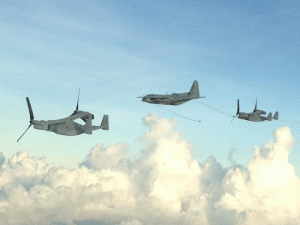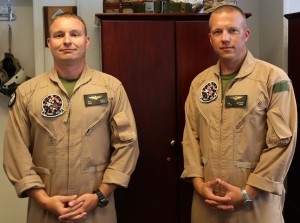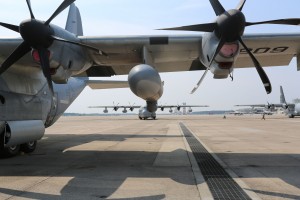2014-07-23 By Robbin Laird
During my latest visit to Second Marine Air Wing, I focused upon the USMC evolution of its use of the KC-130J. The Osprey has been a dramatic addition to the USMC and has made it the only tiltrotar assault enabled force in the world.
What can be lost in the picture is the role of the KC-130J.
The pairing of the two aircraft is changing how the USMC operates and thinks about the range and speed of operations.
The pairing has allowed for the emergence of the Special Purpose MAGTFs, and to Humanitarian Assistance and Disaster Relief (HA/DR) missions such as in the case of the recent Philippine relief mission.

Earlier I had interviewed the CO of the Sumos – the KC-130J squadron which has just moved to Air Station Iwakuni — and he indicated how the pairing worked together to re-shape USMC operations.
https://sldinfo.com/kc-130-squadron-moves-to-air-station-iwakuni/
The pairing between the KC-130Js and the Ospreys has brought an ability to shape organic modularity for long-range insertion of force in the region.
We want to be able to provide for long-range vertical insertion throughout the region and to be able to deploy widely throughout the region as necessary.
It is part of the operational dynamic and part of deterrence as well.
I would add that since the arrival of the Ospreys, about 2/3rds of our tanking requirement is to support the long-range assault support capability, which the Osprey provides.
We can now power project vertical lift anywhere in the region for the MAGTF faster than before.
This is not just an abstract capability, but has been used with effect already in various situations, one of the most visible of which was coming to the aid of the Philippines as part of the shaping function to even set up a relief effort.
And the ability to assist in the Philippines and to leave expeditiously (along with the USAF and USN engagement) was part of background to which the Philippine government re-opened its facilities to US forces in the region.
Put in other words, an agile military capability enabled a political bargain important to the Pacific strategy of defense in depth.
As Lt. Col. “Sniper” Brown, the CO of the “Flying Tigers” or VMM-262 put it:
When the call to fly into the devastated areas came on Veteran’s Day weekend, the challenge was to put together the ability to fly.
“We flew with the Sumos who kept us fueled and carried our logistical needs as well.
But we needed to sort out where to go and what the priorities would be in the initial 72 hours.”
But this capability did not happen overnight; innovation takes time.
It is easy to forget that the KC-130Js preceded the Ospreys by a few years, and it took time to sort out how to use the new capabilities inherent in the KC-130J and with these capabilities to evolve the concept of support.
The introduction of the new aircraft had its challenges.
But the classic notion of lift and tanking associated with the C-130s broadened over time.
The KC-130J not only has broadened its range of mission sets, but has provided a foundational capability for expeditionary support.
It is about supportable reach; not just reach.
When the crew could operate at night operations, the crew broadened its support to the Marines on the ground. When the Harvest Hawk was added, direct fire support to the Marines on the ground became part of the KC-130J operational capabilities, which in turn has established the notion that the airplane can become something different in the future as ISR and C2 engagement expands with the inclusion of UAVs and F-35 systems pushing data to the aircraft.
The point can be simply put: the KC-130J is becoming a significant part of a broadened concept to the Marine Corps assault team.
In an interview with the CO of VMGR-252 and the Executive Officer of the Squadron, the evolution of the role of the KC-130J was the focus of attention.
The CO of the squadron is Lieutenant Colonel Scott M. Koltick and the Executive Officer is Major Ryan Pope, both are very animated, articulate and impassioned about what their squadron contributes to the USMC.

According to his official USMC biography, Lt Col. Koltick has extensive combat experience:
During his 20-year career Lieutenant Colonel Koltick has served in operational and staff billets at every level. He has completed four tours in support of Operation Iraqi Freedom and two tours in support of Operation Enduring Freedom. He was promoted to his current rank in February 2013.
And Major Pope most recently deployed to Afghanistan from July 2013 to February 2014.
The CO provided a succinct overview of how he saw the evolution of the KC-130J.
“When we first got the KC-130J in 2004 and 2005, we flew it exactly like the legacy aircraft.
Our first operational mission was to go to Iraq, and we did our missions in Iraq exactly as we did with the legacy aircraft. We did air refueling and moved cargo and personnel around Iraq and Kuwait. That was how we started.
As we gained more experience in the C-130J, we started evolving that and understanding the whole capability.
We started operating at night with NVGs and we had to learn how to do that from scratch.
And then from there we just incrementally kept expanding the envelope, adding missions as we gained confidence.
Until we’ve arrived at the point we’re at today where — I’m not going to say we’re anywhere near close to exploiting the full capabilities of the J, but widely different from where we were in 2004.

We are now doing long-range refueling of MV-22s over the Atlantic; we have introduced Harvest Hawk, both of which are game changers for us.
With Harvest Hawk we have an ordinance delivering capability and we have a sensor.
Nobody in the C-130 community had any experience with that.
But we went out to other communities asking for help, developing our expertise, and we have able to add those to our mission sets, and now we are at the point we have no external assistance helping us with the Harvest Hawk mission.”
Question: How would you describe the impact of the KC-130J-Osprey pairing on USMC operations?
Lieutenant Colonel Koltick: “The two obvious changes are in your time and in your distance.
Now we can operate much further and we can get there much faster when we pair the V-22 with the C-130J compared to a traditional Marine force.
The range that you get when you combine those two with the refueling and the situational awareness that the K/J has enabled and to be able to push that to the V-22s, changes the context. It’s hard to imagine now an environment on our mission where a MAGTF commander can’t deploy an assault force.
For instance, with Special Purpose MAGTF, they’re routinely thinking in terms of 1,000 nautical mile movements. Whereas a little over 10 years ago, when Gen. Mattis took us into Afghanistan after 9/11, Task Force 58 moved 400 nautical miles and that was groundbreaking.
That was a big deal, but with CH-53s and other helos, we had to land in Pakistan to do that insertion.
Now, a MAGTF commander can easily plan to fly 1,000 nautical miles with an assault package.”

Question: There are three KC-130J squadrons and with the introduction of the Osprey and the re-configuration of the assault force, can the fleet stand up to the demand? Or put another way, is demand outpacing supply?
Lieutenant Colonel Koltick: “The demand is high.
This means that we do not have enough assets available for training with the other parts of the Marine Corps, ranging from low end to high-end training.
We never have enough assets for force training.
The second issue is that the current operational posture of the Marine Corps – forward deployed, disbursed, and facing uncertain challenges in the near and middle term – creates a demand signal that is outstripping supply and we are only in the process of finishing the currently planned full procurement of KC-130Js for the USMC.”
Question: Put in other terms, the reinvention of operational capabilities has driven up the demand for KC-130Js or put in another way, the broadened concept of support, which the KC-130J can provide, has also driven up demand.
Is that a fair way to put it?
Lieutenant Colonel Koltick: “It is.”
Major Pope: “One way to look at the change is to look at the transformation from Iraq to Afghanistan. In Iraq we were largely doing lift and tanking.
By the time we were drawing down in Afghanistan, the KC-130J was a key element within the operations in a number of ways.
Obviously, lift and tanking remain a bedrock of its role.
But now the aircraft is part of the stack of air support and becoming in many ways a host mother ship, if you will.
We are providing communications relays, doing battlefield illumination, putting mission systems aboard the aircraft because we hear the coms and then we had the Harvest Hawk strike capability as well.
Each flight of a multi-function KC-130J becomes almost a sortie generation rate functional equivalent.
We can stay up 10 hours or more and what does that represent in terms of a Harrier sortie equivalent?
A major challenge facing the USMC as it leverages Ospreys and then F-35Bs will be supportable range.
The KC-130J is clearly a key part of any concept of supportable range for the assault force.
And with the evolving multi-mission capabilities of the KC-130J to play the role of a mother ship or to provide ISR and overhead strike, the notion of supportable range can also be broadened as well”.
Editor’s Note: Lt. General Robling, the current Commanding Marine Corps General in the Pacific, has also noted how the projected approach to the distributed laydown is also opening up a demand/supply gap for KC-130Js.
The truth of the matter is the Asia Pacific region is 52% of the globes surface and there are over 25,000 islands in the region. The distances and times necessary to respond to a crisis are significant. The size of the AOR is illustrated in part by the challenge of finding the missing Malaysian airliner.
If you don’t have the inherent capability like the KC-130J aircraft to get your equipment and people into places rapidly, you can quickly become irrelevant. General Hawk Carlisle uses a term in his engagement strategy which is “places; not bases”.
America doesn’t want forward bases. This means you have to have the lift to get to places quickly, be able to operate in an expeditionary environment when you get there, and then leave when you are done.
Strengthening our current partnerships and making new ones will go a long way in helping us be successful at this strategy. We have to be invited in before we can help. If you don’t have pre-positioned equipment already in these countries, then you have to move it in somehow.
And, right now, we’re moving in either via naval shipping, black bottom shipping, or when we really need it there quickly, via KC-130J aircraft or available C-17 aircraft. Right now, we are the only force in the Pacific that can get to a crisis quickly, and the only force that operates as an integrated air, sea and ground organization.
The Slideshow below provides a highlight of some VMGR-232 activities:
An MV-22B Osprey with Marine Helicopter Squadron 1 receives fuel from a KC-130J Super Hercules from Marine Aerial Refeuler Transport Squadron 252 over the Atlantic May 28, 2014.
The Osprey, along with three others from HMX-1, refueled mid-flight during the squadron’s first trans-Atlantic flight. 6/2/14
The photos are credited to 2nd Marine Air Wing, except for the last one which is credited to 3rd Marine Air Wing.
- The next two photos show a KC-130J Hercules property of Marine Aerial Refueler Transport Squadron (VMGR) 252, refuels an MV-22 Osprey assigned to Marine Medium Tiltrotor Squadron (VMM) 264 and 266 over the Atlantic Ocean, off the coast of N.C., April 14, 2014. VMGR-252 conducted aerial refueling training with VMM-264 and 266. 04/14/2014
- In the fourth photo, A KC-130J Hercules aircraft assigcned to Marine Aerial Refueler Transport Squadron 252, is staged at Camp Bastion, Helmand province, Afghanistan, Aug. 15, 2013. The aircraft was staged prior to flight.
- In the fifth photo, an F/A-18 Hornet, from Marine Fighter Attack Squadron 314, connects to a refueling hose from Marine Aerial Refueler Transport Squadron 252, June 12. Marine Aerial Refueler Transport Squadron 252’s mission is to provide transportation of personnel, equipment and supplies, and to provide aerial refueling for fixed and rotary wing aircraft. 6/12/09
- In the sixth photo, KC-130J Hercules with Marine Aerial Refueler Transport Squadron 252 cruises alongside a fellow Hercules from the squadron while conducting flight patterns during aerial refueling training May 22, 2013
- In the photos from 7-9, an AV-8B Harrier aircraft receives fuel during an aerial refuel mission over Helmand province, Afghanistan, May 10, 2013. A KC-130J Hercules aircraft was responsible for executing the mission by resupplying other aircraft. 5/10/13
- In the tenth image, an illustration shows North Atlantic Treaty Organization nations standard refuel rendezvous procedures for configurations, air speeds and communications when refueling fixed wing aircraft. “We work the aircraft left to right, low to high,” explained Staff Sgt. Paul Folk, crew chief with Marine Aerial Refueler Transport Squadron 252. “The system alleviates people from flying all over the place.” VMGR-252 worked with F/A-18 Hornets from Marine Corps Air Station Beaufort, S.C., and AV-8B Harriers from Cherry Point as part of a large-force exercise in the Eastern Carolina skies Jan. 26-27. 1/27/11
- In the final photo, the “Harvest Hawk” mission kit uses a AN/AAQ-30 Targeting Sight System (left) and a AGM-114P Hellfire II weapons system (right) mounted on the left wing of a KC-130J. A fire control operator at a fire control station located in the rear of the aircraft monitors these systems. 8/29/09
And for a look at the Harvest Hawk configuration and its operational approach see the following video:
Harvest Hawk in Afghanistan from SldInfo.com on Vimeo.

